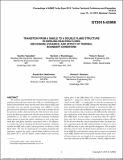Transition From a Single to a Double Flame Structure in Swirling Reacting Flows: Mechanism, Dynamics, and Effect of Thermal Boundary Conditions
Author(s)
Sanusi, Yinka S.; Mokhiemer, Esmail M. A.; Taamallah, Soufien; Shanbhogue, Santosh; Ghoniem, Ahmed F
DownloadGhoniem_Transition from.pdf (3.498Mb)
PUBLISHER_POLICY
Publisher Policy
Article is made available in accordance with the publisher's policy and may be subject to US copyright law. Please refer to the publisher's site for terms of use.
Terms of use
Metadata
Show full item recordAbstract
We examine experimentally the transition from a single flame stabilized along the inner shear layer (ISL) to a double flame stabilized along both the inner and the outer shear layers (OSL) and spreading over the outside recirculation zone (ORZ) in a fully premixed swirl-stabilized combustor. This work is mainly driven by previous studies demonstrating the link between this transition in the flame macrostructure and the onset of thermo-acoustic instabilities. Here, we examine the transition mechanism under thermo-acoustically stable conditions as well as the dominant flow and flame dynamics associated with it. In addition, we explore the role of changing the thermal boundary conditions around the ORZ and its effect on the presence or absence of the flame there. We start by analyzing the two flames bounding the transition, namely the single conical flame stabilized along the ISL (flame III) and the double conical flames with reactions taking place in the ORZ (flame IV). A dual chemiluminescence approach — using two cameras with a narrow field of view focused on the ORZ — is undertaken to track the progression of the flame as it reaches the ORZ. During the transition, the flame front, initially stabilized along the ISL, is entrained by OSL vortices close to where the turbulent jet impinges on the wall, leading to the ignition of the reactants in the ORZ and the ultimately the stabilization of the flame along the outer shear layer (OSL). This ORZ flame is also subject to extinction when the equivalence ratio (ϕ) is between values corresponding to flames III and IV. For ϕ lower than the critical transitional value, the flame kernel originating from the ISL-stabilized flame is shown to reach the ORZ but fails to grow and quickly disappears. For ϕ higher than the critical value, the flame kernel expands as it is advected by the ORZ flow and ultimately ignites the reactants recirculating in the ORZ. Sudden and extreme peak-to-peak values of the overall heat release rate are found to be concomitant with the ignition and extinction of the ORZ reactants. Finally, Different thermal boundary conditions are tested by modifying the heat flux through the combustion chamber boundary, particularly around the ORZ. We find that the transition is affected in different ways: while the transition from flame III to IV (i.e. as ϕ increases) is insensitive to these changes; flame IV persists at lower ϕ as its value is reduced when heat losses through the boundaries are diminished.
Date issued
2015-06Department
Massachusetts Institute of Technology. Department of Mechanical EngineeringJournal
Proceedings of ASME Turbo Expo 2015: Turbine Technical Conference and Exposition GT2015
Publisher
American Society of Mechanical Engineers (ASME)
Citation
Taamallah, Soufien et al. “Transition From a Single to a Double Flame Structure in Swirling Reacting Flows: Mechanism, Dynamics, and Effect of Thermal Boundary Conditions.” ASME Turbo Expo 2015: Turbine Technical Conference and Exposition, 15-19 June, 2015, Montreal, Quebec, Canada ASME, 2015. © 2015 by ASME
Version: Final published version
ISBN
978-0-7918-5673-4